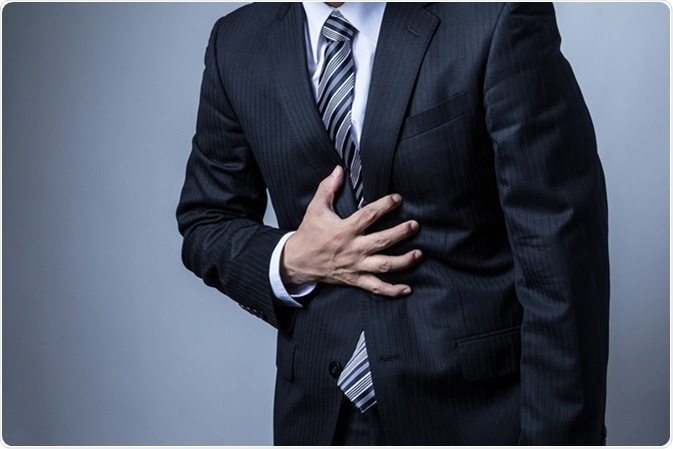Heartburn (Acid Reflux) Triggers

Heartburn can be the result of a wide variety of foods and stressors. Different people react to different things in different ways. Thus, the following discussion is not meant to point to a uniform list of triggers, but to indicate some potential substances and situations that may increase the risk of bringing on this uncomfortable or even painful condition.
In general, heartburn may be caused by food, exercise, medications, position, and some anatomical variations. Thus, each individual must find out what triggers the sensation in his or her own case.
 Acid Reflux) Triggers” />
Acid Reflux) Triggers” />Food
Eating large meals is a sure trigger for heartburn in many patients. This is especially so if the meal is fatty and is taken very shortly before going to bed.
After a large meal, the stomach is filled with food and acidic gastric juice, which may overflow through the lower esophageal sphincter. This is a circular muscle that closes off the top of the stomach from the food pipe. This sphincter is normally closed tightly enough to keep food and gastric acid where they belong. However, too much pressure on this circular muscle causes stretching and this eventually leads to a loss of tightness. As a result, some of the gastric contents leak through, causing inflammation of the mucous lining of the esophagus, which in turn causes heartburn.
Foods which contain a lot of fat, such as a greasy burger and French fries, are also commonly implicated in heartburn. This is because fats are known to slow down the transit of food through the intestinal tract, as well as stimulate the production of more acid as the food remains in the stomach for a longer time. Again, this relaxes the lower esophageal sphincter, causing the acidic food to regurgitate or move upwards through it, thereby irritating the esophagus.
In some cases, alcohol consumption has also been implicated in causing heartburn. Other foods that cause acid reflux in some people include:
- Spices, such as black pepper, onions and garlic
- Citrus fruits, which are known to contain large amounts of citric acid
- Caffeinated drinks including tea, coffee and sodas
- Peppermint
- Chocolate
Exercise
Exercise is highly recommended for overall health and cardiovascular fitness. However, some exercises involving the abdominal muscles, such as crunches, put a lot of pressure on the abdominal wall and force gastric contents back up into the food pipe.
In people with much fat around the waist, and in pregnant women, the pressure on the diaphragm exerted by the bulky abdomen, and therefore on the lower esophageal sphincter, is higher and the occurrence of heartburn is more common.
The kinds of exercise likely to culminate in heartburn (when done soon after a meal) include:
- Headstands
- Crunches
- Leg lifts
- Jogging
- Aerobics
Medications
Most medications that irritate the gastric mucosa can cause heartburn if taken without first eating sufficient food. These include:
- Non-steroidal anti-inflammatory drugs (NSAIDs), commonly called painkillers, and used for everything from fever to arthritis, induce heartburn, because they stimulate increased acid production by the stomach cells.
- Anti-hypertensives or drugs used to lower the blood pressure – some of these medications, like calcium channel blockers or beta blockers act by relaxing the smooth muscle of the arterial wall. The same action also relaxes the lower esophageal sphincter and so makes heartburn more common.
- Some sedatives and antidepressants cause relaxation of the lower esophageal sphincter, while some opiates reduce its tone.
- Some drugs used to treat Parkinson’s disease and other related conditions have also been implicated in acid reflux.
- Certain progestin hormones may increase the time taken to clear food from the stomach after a meal.
- Some chemotherapy drugs may irritate the mucous lining of the esophagus.
- Bisphosphonates are also highly irritant to the esophagus.
Other triggers
Hiatus hernia
Some people develop a condition in which some of the uppermost part of the stomach actually pushes up through the opening in the diaphragm designed to allow the esophagus to pass through. This disrupts the normal function of the lower esophageal sphincter, of course, and heartburn often results.
Position
Some people find that leaning forward or lying down soon after a meal triggers heartburn especially after certain types of food.
Anxiety
Stress and worry increases gastric activity and acid secretion, and is often the trigger for heartburn in many people.
Conclusion
The best way to find out which foods actually irritate the stomach are by tracking what you eat, how much, and when, in relation to the pain of heartburn. This heartburn diary must also note the time and kind of exercise activity, medications, and pain – the timing and nature of the pain and how it is relieved.
Knowing what triggers your heartburn can help avoid that particular combination of circumstances in the future. If medications are the cause, this must be discussed with your healthcare provider, because a change of drug, where possible, may be helpful.
Sources
- www.mayoclinic.org/…/syc-20373223
- https://www.ncbi.nlm.nih.gov/books/NBK279254/
- https://medlineplus.gov/ency/article/003114.htm
- www.health.harvard.edu/…/what-to-eat-when-you-have-chronic-heartburn
- https://www.healthdirect.gov.au/heartburn
- www.betterhealth.vic.gov.au/health/conditionsandtreatments/indigestion
Further Reading
- All Heartburn Content
- What is Heartburn (Acid Reflux)?
- Heartburn (Acid Reflux) Diagnosis
- Heartburn (Acid Reflux) Prevention
- Heartburn (Acid Reflux) Treatments
Last Updated: Feb 13, 2019

Written by
Dr. Liji Thomas
Dr. Liji Thomas is an OB-GYN, who graduated from the Government Medical College, University of Calicut, Kerala, in 2001. Liji practiced as a full-time consultant in obstetrics/gynecology in a private hospital for a few years following her graduation. She has counseled hundreds of patients facing issues from pregnancy-related problems and infertility, and has been in charge of over 2,000 deliveries, striving always to achieve a normal delivery rather than operative.
Source: Read Full Article